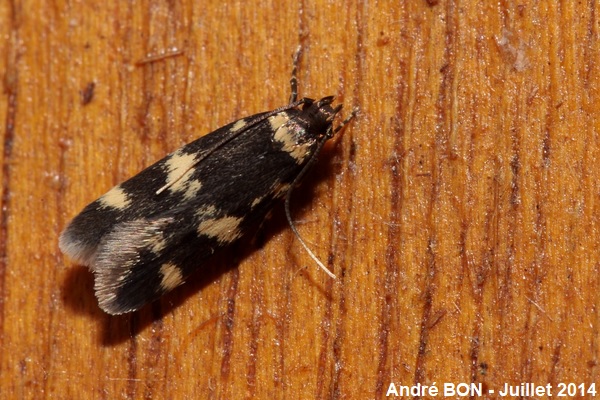
| Oegoconia sp. (Stainton, 1854) |

|
|
Scientific name: Oegoconia sp. (Stainton, 1854) Common name: French name: Order: Lepidoptera Suborder: Microlepidoptera Family: Autostichidae Subfamily: Oegoconiinae Wingspan: 11-17 mm. Biotope: Geographic area: Oegoconia annae (Sutter, 2007) : Sardinia; Oegoconia ariadne (Gozmány, 1988) : Crete, the Dodecanese and the Aegean islands; The Straw Obscure Moth (Oegoconia caradjai - Popescu-Gorj & Capuse, 1965) : Europe, New Zealand; Oegoconia ceres (Sutter, 2007) : Sardinia; The Scarce Obscure Moth (Oegoconia deauratella - Herrich-Schäffer, 1854) : Europe, North America; Oegoconia deluccai (Amsel, 1952) : Malta; Oegoconia huemeri (Sutter, 2007) : Croatia, Italy, Sicilia, Switzerland, France, Spain; The Four-spotted Yellowneck Moth or Four-spotted Obscure Moth (Oegoconia quadripuncta - Haworth, 1828) synonym of Oegoconia novimundi (Busck, 1915) : Europe, north to Germany, Ireland, Wales, southern part of England, North America; Oegoconia uralskella (Popescu-Gorj & Capuse, 1965) : Europe; Oegoconia praeramis (Meyrick, 1918) : Sri Lanka; Oegoconia meledantis (Meyrick, 1921) : South Africa; Oegoconia syndesma (Meyrick, 1926) : South Africa. Flight time: June to August in continental Europe. You may observe specimens later in the year inside buildings. Number of generations : 1 Caterpillar: Host plant: Dead leaves, decaying plants, straw and hay. |
I have found 12 species listed in the Oegoconia genus with 9 of them found in Europe. The range of 4 of these species is limited to some Mediterranean islands. So you can only observe 5 of these species in continental Europe and in particular in Metropolitan France. We will only deal with these 5 species. They are very similar and so very difficult to separate. They show black to blackish brown fore wings with whitish or whitish yellow markings, one basal patch, sub-basal lateral spots sometimes missing, one more or less broad or interrupted median band and submarginal spots. The palps are upcurved over the head. You can recognize the Straw Obscure Moth (Oegoconia caradjai) with its yellow orange head and its completely yellow palps, in particular the last articles. Oegoconia uralskella also shows a yellow orange head but some dark parts on the last articles of the palps. The Scarce Obscure Moth (Oegoconia deauratella), Oegoconia huemeri and the Four-spotted Obscure Moth (Oegoconia quadripuncta) can only be reliably separated by a close exam of the genitalia. |
| [To know more about the Oegoconia sp.] [Top] |

|
The dark head indicates one member of the Oegoconia deauratella, Oegoconia huemeri, Oegoconia quadripuncta group. So I will just list this moth as Oegoconia sp. |